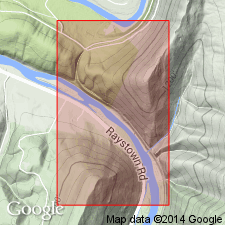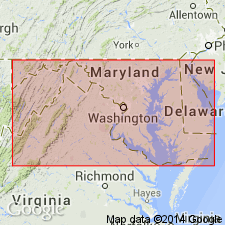
- Usage in publication:
-
- Riddlesburg shale
- Modifications:
-
- Named
- Dominant lithology:
-
- Shale
- AAPG geologic province:
-
- Appalachian basin
Summary:
Named Riddlesburg shale for Riddlesburg, Bedford Co., PA. Consists of 75 feet of greenish-black siliceous shale, exfoliating into pencil forms, with marine fossils in lower part. Unit is included in Pocono series, lying 410 feet below base of Logan (Burgoon) sandstone, the top division of the Pocono. Riddlesburg is overlain by 20 feet of green sandstone and underlain by 15 feet of greenish-gray shaly sandstone. What seems to be the same black shale occurs also in Alleghany Co., VA. Age is considered Mississippian.
Source: GNU records (USGS DDS-6; Reston GNULEX).

- Usage in publication:
-
- Riddlesburg Member
- Modifications:
-
- Revised
- Dominant lithology:
-
- Sandstone
- AAPG geologic province:
-
- Appalachian basin
Summary:
The Riddlesburg contains significant sandstone in the study area and therefore the name is changed from Riddlesburg Shale Member to Riddlesburg Member of the Price Formation. Unit includes at its base, a massive sandstone referred to the Cussewago Sandstone Member by Kammer and Bjerstedt (1986). Boswell and others do not agree with this correlation and here restrict use of the term Cussewago from this area. The westward boundary between the Riddlesburg and the Cuyahoga Formations is located arbitrarily where the thickness of the overlying Rockwell Formation decreases below 3 m.
Source: GNU records (USGS DDS-6; Reston GNULEX).

- Usage in publication:
-
- Riddlesburg Member
- Modifications:
-
- Overview
- AAPG geologic province:
-
- Appalachian basin
Summary:
Author proposes that Rockwell and Purslane Formations be used instead of Pocono in MD. Pocono of previous usage in study area is abandoned. Rockwell divided into (ascending) Finzel Marine Tongue, lower nonmarine facies, Riddlesburg Member, and upper nonmarine facies. At Altamont, Riddlesburg consists of 38 ft of gray to black shale containing orbiculoid brachiopods and bivalves. At Keysers Ridge, unit is characterized by fossiliferous marine sandstones. At La Vale, consists of 30 ft of unfossiliferous, well-sorted, tabular, cross-bedded, medium-grained sandstone. Riddlesburg is a widespread and easily recognized unit, and can be used as a means of correlation.
Source: GNU records (USGS DDS-6; Reston GNULEX).
For more information, please contact Nancy Stamm, Geologic Names Committee Secretary.
Asterisk (*) indicates published by U.S. Geological Survey authors.
"No current usage" (†) implies that a name has been abandoned or has fallen into disuse. Former usage and, if known, replacement name given in parentheses ( ).
Slash (/) indicates name conflicts with nomenclatural guidelines (CSN, 1933; ACSN, 1961, 1970; NACSN, 1983, 2005, 2021). May be explained within brackets ([ ]).

